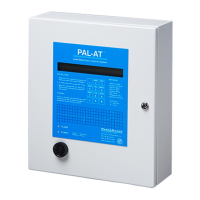PAL-AT Installation Manual
22
5 Cable Installation in Secondary Contained Piping
5.1 General
In secondary contained pipe applications, the sensor cable is installed in the bottom (6 o’clock position) of
the air space between the product pipe(s) and secondary containment (outer casing or conduit). The leak
detection cable is a sensitive sensor, capable of detecting small amounts of liquid. Therefore, every effort
must be made to keep the cable dry and prevent water from entering the air space. In addition,
long-term accumulations of water, corrosive liquids, or hydrocarbon liquids in the containment
pipe may degrade the containment or the leak detection system components. The piping system
must remain sealed during installation to prevent moisture entering the system. The installing contractor
must install caps on the open ends of pipe installed in a trench to prevent liquids from entering the conduit
or containment pipe.
Caution: A heated system using mineral wool or fiberglass insulation should be carefully
monitored during startup. If the insulation is wet (even from atmospheric moisture) prior to
startup, the water may combine with the ammonium sulfate binders in the insulation and release
ammonia when the pipe is heated. The ammonia is detrimental to the leak detection cable and
may be detrimental to the piping system if left uncorrected.
If the system becomes wet, it must be completely dried. Drying methods can consist of pulling a vacuum
on the interstitial space, using compressors with desiccant dryers, or other methods. Obtain guidance
from your piping supplier on proper techniques to be used with your system.
This section is intended to cover installation methods typically employed with any fabricated secondary
contained pipe systems. Typically, these manufactured products are custom fabricated with product pipes
positioned by specially designed supports within the secondary containment. All pipe supports and
changes in direction must have guides constructed out of stainless steel, minimum ¾" [20 mm] ID
tubing, with flared ends. Plastic supports must be avoided when the carrier pipe is metal. Consult
with the piping system manufacturer before installation to ensure provisions are being made for
the cable installation. Because the sensor cable installation is dependent upon the design provisions
employed by the pipe manufacturer, it is recommended the secondary pipe manufacturer supply the leak
detection/location products. This sole source responsibility will greatly facilitate proper installation with
lower cost.
The following charts are general references for installing a sensor cable into field-constructed secondary
contained pipe system built with piping components. Typically, these systems are constructed using
standard lengths of pipe and fittings for the product and secondary containment structures. Components
of the piping system should be designed, manufactured, and installed to facilitate sensor cable installation.
Because the sensor cable is placed on the bottom of the air space, there must be a continuous
unobstructed passage for the cable(s) being pulled into the system. PermAlert recommends a 1" [25
mm] air space. Pipe support design and alignment is critical. Pipe supports and other surfaces
the cable contacts during “pulling” operations must be smooth to prevent snagging or damaging
the cable.
Field joint designs and procedures employed in the installation of the piping system must prevent
damage to the pull rope and/or sensor cable.
Pull ropes must be installed as the pipe system is assembled together to facilitate the installation. Special
stainless steel ¾" [20 mm] ID guide tubes must be installed in the air space of the containment straight,
elbows, tees and wyes (lateral) at the factory. Pull points must be designed and provided at specific
locations to facilitate the installation of the pull cable and leak detection cable. The recommended
minimum bend radius for all sensor and jumper cables is 1.5” [38mm].
Leak Detection Sizing Chart

